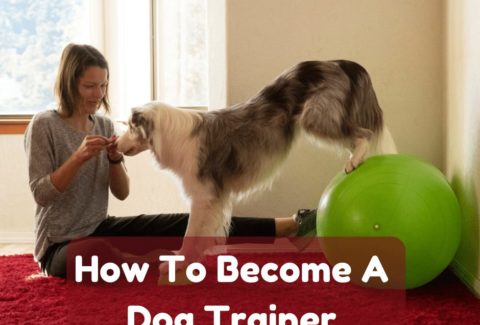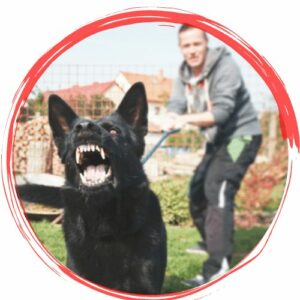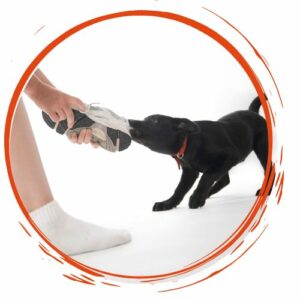How To Be A Good Dog Training Student
May 19, 2021 2021-05-19 0:43How To Be A Good Dog Training Student
How To Be A Good Dog Training Student

Nearly everyone who comes to me to train their dog is an adult and has long left their years in school behind them. Over the years I have only taught a couple kids that came to me either because they did training in 4H or because they simply enjoyed training and wanted to teach more and more tricks to their dog.
Every single one of those kids has been a perfect student. Of course – they practice how to be a good learner every day, and their teachers at school do a fantastic job at guiding them on how to receive feedback and put it into action.
Sometimes we adults however seem to lose this ability a bit down the road. Over time we pick up more and more traits that make us a less than a perfect student. Unfortunately this does slow down the learning progress and even a wonderful dog and great teacher can only go so far if the learner does not have the right attitude for receiving instruction and trying it out.
That’s why today, I want to share with you my Do’s and Don’ts for being a good dog training student!
Don’t Tell Me Why My Tips Won’t Work
(At least not right away)

Something that’s really difficult as a trainer is to think of a training plan, an exercise or game idea, a way to help the dog and owner get better at a skill – and when I tell the owner how to do it, I am met with:
This won’t work because …
Do not do this! (At least not before trying it first)
The thing is – your trainer has probably trained many, many dogs with the same or similar problem before yours. And while every dog is an individual and has his own quirks and idiosyncrasies, they also – just like people – all follow the same underlying rules of behavior and learning.
Your trainer might not know your dog yet, but (s)he knows many other dogs, and (s)he knows how dogs learn and think.
When your trainer gives you a training idea, do not assume that you know best why this will or won’t work. Unless your trainer got some major aspect of the advice wrong (for example suggesting an exercise based on toy rewards for an only food-driven dog), do not say:
“Rewarding my dog for attention is not going to work because once I did that and he turned around and left …”
It’s not a good way to respond to feedback, and chances are that the advice is well-thought out and will actually work very effectively. That’s why you should:
Do Give Everything A Fair Shot

Before discarding a piece of advice – whether that is a small tip on how to change your reward delivery or a bigger change such as a different daily schedule for your dog – give it a fair chance.
Many times, you will not see the final result after couple tries. In order to really know where your training is going, you should put your trainer’s ideas into action for a week or two at the very least.
Changes take time – that is true for both humans and dogs. It especially applies to changes in habits or ingrained behaviors.
While it is rather easy and fast to start teaching a completely new behavior (you can teach your dog in a single session how to sit, spin left or right, stand between your legs etc.) because the dog has no prior expectations and perception of how things should be – retraining an already learned behavior will take more time.
If your dog for example has practiced pulling on leash for the last 4 years, your trainer will very likely not be able to undo this in a single session. Our own leash walking course is completed by most students within 4-6 weeks – if they give up after the first day, then yes – the dog will probably pull on leash just as he always has.
Of course: If after a week or two you see absolutely zero change (for “easier” issues such as attention and leash walking troubles … difficult behavior modification is a different story), you can let your trainer know and (s)he might have suggestions for how to modify the training plan to get better results.
When you do this however, be sure to keep in mind:
Don’t Lie About Whether You Practiced
Your trainer might have given you homework and then life happened – a long work week, your car broke down, your family needed you … there are many reasons why dog training might have been pushed to the back burner.
It is really important that you do not lie about how much you practiced, because this will actually make the training process much more difficult.
Say your trainer gave you instructions for how to improve your dog’s stay on a mat and you just didn’t get around to practicing. Mat work is pretty much errorless learning in the beginning stages: you pick an easy enough location, great treats and a high rate of reinforcement and there will be no reason for the dog to not stay on the mat.
But if you come back the next week and tell your trainer that your dog won’t stay on the mat at all while claiming you did practice, this will make your trainer wonder:
- Are we using the wrong treats?
- Did they practice in the wrong locations?
- Does the dog dislike the mat for some reason (previous association of the mat with the punishment or in a scary situation such as a vet visit)?
- Did we unknowingly set the dog up for failure in this exercise that should be pretty much fail-proof?
Your dog trainer doesn’t assume that the easy answer to those questions is “No – the student just lied.”
How much you practiced is actually a really important piece to solving the training puzzle. It will be crucial for your trainer to know how many repetitions and training in different places lead to the behavior your dog is performing.
Don’t Be Confused
The worst scenario for me is not that a student doesn’t practice at home in between sessions (after all – life happens! It is ok. Just be honest about it and we will pick up where we left off), but that (s)he does try to practice and gets confused in what the exercise or game was all about.
Confusion on the owner’s and the dog’s side often leads to frustration. And frustration leads to disliking training – the exact opposite of what I had in mind.
If you are confused, ask your trainer for clarification. Your trainer wants you to succeed. He or she knows that training sometimes goes along with some misunderstandings or need for multiple explanations. That’s also why there is this next rule:
Do Ask Questions, Even If They Are Repetitive
Please don’t be afraid to ask the same question twice. Or five times. Or ten times.

Dog training is not an easy skill! If you need your trainer to show you three times in a row how to lure your dog into a Down or how to best reward him in position – ask. Ask questions about how often you should train, how long you should work on a specific skill before progression, how to react if your dog makes a mistake. Ask all the questions you have!
I love when my students ask questions. It shows that they are on the right path in their learning and dog training journey.
If your trainer gets annoyed by questions or refuses to answer them, maybe it’s time for a better trainer!
And finally:
Do Come Prepared
It is really difficult to train a dog without rewards that the dog finds rewarding. If you know that your dog works best for chicken or liver treats and you arrive at your lesson with only kibble – well, there is only so much your trainer can do if your dog doesn’t feel like training for that (i.e. if the environment is more fun than your dry food).
My best students are the ones who always come prepared!
Bring treats your dog loves. If your dog tends to be easily distracted, bring a long line we can attach to keep him from wandering off. If we have been training with a specific place mat, bring the mat.
Just 5 minutes of preparation before the lessons can make your training vastly more successful! Pack a bag of anything you might need during training and your will make much more progress, because you are prepared to give him the best possible learning experience.
Ideally, put everything you have used in your past lessons in that bag – treats, clicker, spoon and spray cheese (my online students know what I am talking about!), any toys your dog likes, a long and a short leash etc. It is not your trainer’s job to have everything your dog likes and wants on hand (or I would need more than just one bag for all the dogs I train with – probably a whole RV full of different stuff 😉 )
And now… happy training.







